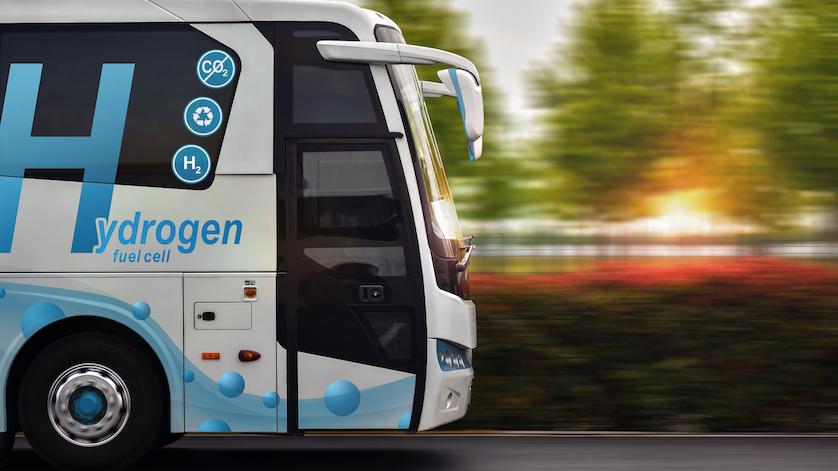
While not as far along as other industrialized nations, the United States is seeing a definite move toward hydrogen-powered vehicles as a way to transition from carbon-based fuels.
Some of the world’s largest economies are enthusiastically embracing hydrogen fuel cells and hydrogen vehicles in 2023 as a way to reduce their carbon emissions and eliminate it altogether one day. Here are a few examples of recent decarbonization initiatives around the world:
- Japan is pushing hard for a hydrogen-based society. The country created its Basic Hydrogen Strategy in 2017, and the next year hosted the Hydrogen Energy Ministerial Meeting among interested governments. The Toyota Mirai is the world’s first commercially available fuel cell electric vehicle (FCEV), and Japan currently has the world’s largest facility for producing H2 using renewable energy: the Fukushima Hydrogen Energy Research Field (FH2R).
- Germany’s National Hydrogen Strategy has a 38-measure action plan that the country and the European Union will take by the end of 2023. The country currently has 90 hydrogen filling stations – the second biggest network after Japan’s 135 – with more in progress.
- South Korea and Hyundai have a vision of 2.9 million FCEVs by 2040. The country’s HyNet consortium plans to build 100 new hydrogen refueling stations by next year.
- China’s plan for a hydrogen economy includes more than 1 million FCEVs and 1,000 hydrogen refueling stations by 2030.
- France presented its national hydrogen strategy in September 2020. Of the €7.2 billion investment by 2030, €1.5 billion will be spent on electrolysis plants and €1 billion on heavy trucks.
- The EU-funded JIVE (Joint Initiative for hydrogen Vehicles across Europe) seeks to deploy hydrogen-powered buses throughout its member states.
- Australia introduced its National Hydrogen Strategy in late 2019, with the ultimate goal of the country being a “major global player in clean hydrogen by 2030.”
- Canada recently released its Hydrogen Strategy, which includes a clean hydrogen economy as part of its goal to achieve net-zero greenhouse gas emissions by 2050.
Bumpy Acceleration Toward Hydrogen in the US
The United States has had several stops and starts on its hydrogen journey. George W. Bush was a major and early proponent of hydrogen fuel cells. Obama eliminated his predecessor’s $1.2 billion hydrogen plan, but changed course four years later to back fuel cells. Although Trump championed coal and other fossil fuels, in November 2020 the Department of Energy released its Hydrogen Program Plan to further research, development, and demonstration activities.
The Biden administration intends to invest $400 billion in clean energy and innovation over the next decade. In California, Gov. Newsom’s September 2020 executive order says that starting in 2035, all new cars and passenger trucks sold in the state will be zero emissions, and “all operations of medium- and heavy-duty vehicles shall be 100% zero emissions by 2045 where feasible.” While neither plan specifically mentions hydrogen, the understanding is that zero-emission vehicles include FCEVs.
In March 2023, senators Chris Coons (D-Delaware) and John Cornyn (R-Texas) introduced a package of four bills to support the adoption of hydrogen in shipping ports, industry, trucking, and hydrogen infrastructure and innovation.
It’s true that the US is nowhere as far along as some of its Asian and European competitors when it comes to hydrogen adoption. As of September 2023, there are only 57 retail hydrogen stations in the country, 56 of which are in California.
Hydrogen Fuels Cells Predicted to Be on the Rise in 2023
Yet in a shift so gradual that it’s difficult for most Americans to perceive, interest in hydrogen technology is rising, as seen in the business sector:
- In addition to a new battery system, General Motors is working with Honda on Hydrotec, its hydrogen fuel cell technology. GM also bought an 11% stake in Nikola, the Phoenix-based manufacturer of zero-emission semitrucks using battery or hydrogen fuel cell technology.
- Toyota and truck maker Hino will develop hydrogen fuel cell trucks for the North American market. Toyota is also collaborating with Washington-based Kenworth to develop heavy-duty hydrogen trucks.
- The CEO and chairman of Cummins, the Indiana-based manufacturer of engines, said at the company’s 2020 Hydrogen Day: “Hydrogen technologies, particularly electrolyzers, will be a fast-growing and increasingly important part of our business over the next few years” and that “at some point in the future, it will be the single largest part of what Cummins provides to customers.”
- CF Industries, the Illinois-based fertilizer company, has joined the global Hydrogen Council as part of its commitment to “decarbonize the world’s largest ammonia production platform.”
- Other US members of the Hydrogen Council’s steering committee include 3M, Air Products, Chemours, Cummins, GM, and Microsoft.
Although the US is slower than some other nations in embracing hydrogen vehicles, the country is, in fact, a global leader when it comes to hydrogen technologies. In addition to the above examples, New York-based Plug Power was the chosen partner for France’s Renault and South Korea’s SK Group to supply hydrogen and fuel cell product.
This three-part series continues next week with Hydrogen Mobility: The Future of Clean Engines Meets Today’s Standards.


Hi wika.us webmaster, Keep the good content coming!
Insightful Content. Please share such more content.